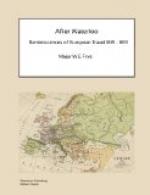VENICE, 26th May.
I was much struck, as everyone must be who sees it for the first time, at the singular appearance of Venice. An immense city in the midst of the Ocean, five miles distant from any land; canals instead of streets; gondolas in lieu of carriages and horses! Yet it must not be inferred from this that you are necessarily obliged to use a gondola in order to visit the various parts of the city; for its structure is as follows. It is built in compartments on piles on various mud banks, always covered indeed by water, but very shallow and separated from each other (the mud banks I mean) by deep water. On each of these compartments are built rows of houses, each row giving front to a canal. The space between the backs of the rows of houses forms a narrow street or alley paved with flag stones, very like Cranborn Alley for instance; and these compartments are united to each other (at the crossings as we should say) by means of stone bridges; so that there is a series of alleys connected by a series of bridges which form the tout ensemble of this city; and you may thus go on foot thro’ every part of it. To go on horseback would be dangerous and almost impracticable, for each bridge has a flight of steps for ascent and descent. All this forms such a perfect labyrinth from the multiplicity and similarity of the alleys and bridges, that it is impossible for any stranger to find his way without a guide. I lost my way regularly every time that I went from my inn to the Piazza di San Marco, which forms the general rendezvous of the promenaders and is the fashionable lounge of Venice; and every time I was obliged to hire a boy to reconduct me to my inn. On this account, in order to avoid this perplexity and the expence of hiring a gondola every time I wished to go to the Piazza di San Marco I removed to another inn, close to it, called L’Osteria della Luna, which stands on the banks of the Canale grande and is not twenty yards from the Piazza.
I then hired a gondola for four days successively and visited every canal and every part of the city. Almost every family of respectability keeps a gondola, which is anchored at the steps of the front door of the house. After the Piazza di San Marco, of which I shall speak presently, the finest buildings and Palaces of the nobility are on the banks of the Canale grande, which, from its winding in the shape of an S, has all the appearance of a river. The Rialto is the only bridge which connects the opposite banks of the Canale grande; but there are four hundred smaller bridges in Venice to connect the other canals.




